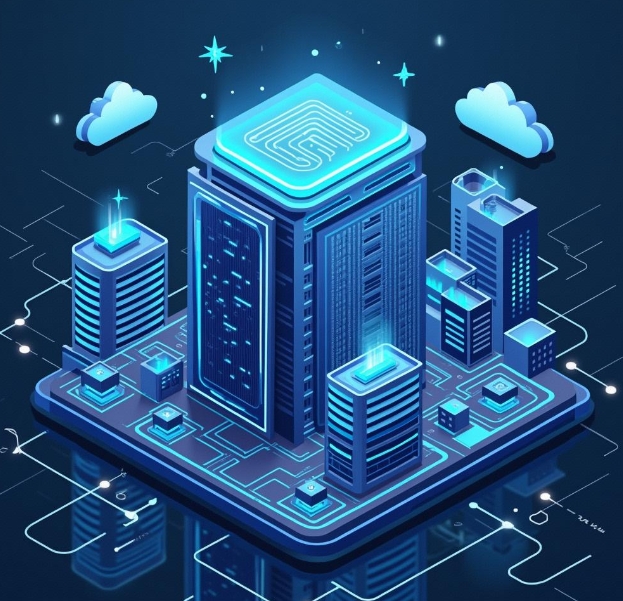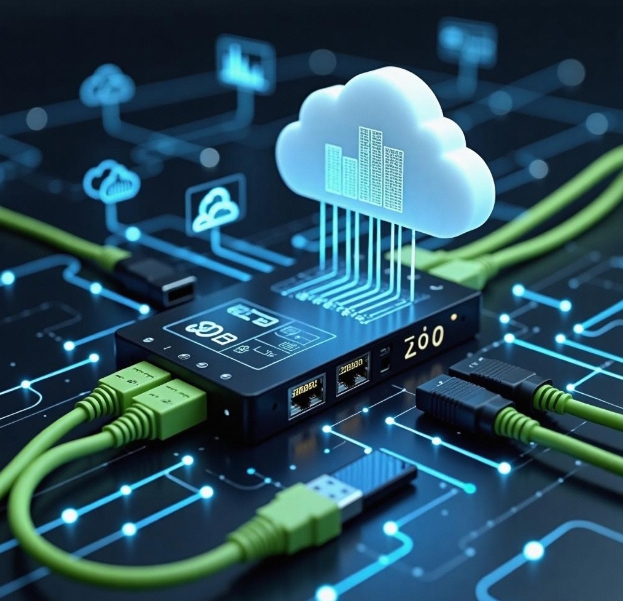Integration of Cloud Computing and the Internet of Things: Driving the Development of Smart Cities
- latest articles
- 1.DApp Development & Customization: Merging Diverse Market Needs with User Experience 2.Analysis of the Core Technical System in DApp Project Development 3.How to achieve cross-chain interoperability in Web3 projects? 4.How does the tokenization of points reconstruct the e-commerce ecosystem? 5.How to Set and Track Data Metrics for a Points Mall? 6.What is DApp Development? Core Concepts and Technical Analysis 7.Inventory of commonly used Web3 development tools and usage tips 8.Development of a Distribution System Integrated with Social E-commerce 9.Six Key Steps for Businesses to Build a Points Mall System 10.What is DApp Development? A Comprehensive Guide from Concept to Implementation
- Popular Articles
- 1.Future Trends and Technology Predictions for APP Development in 2025 2.Analysis of the DeFi Ecosystem: How Developers Can Participate in Decentralized Finance Innovation 3.From Zero to One: How PI Mall Revolutionizes the Traditional E-commerce Model 4.DAPP Development | Best Practices for Professional Customization and Rapid Launch 5.Recommended by the Web3 developer community: the most noteworthy forums and resources 6.From Cloud Computing to Computing Power Leasing: Building a Flexible and Scalable Computing Resource Platform 7.How to Develop a Successful Douyin Mini Program: Technical Architecture and Best Practices 8.Shared Bike System APP: The Convenient Choice in the Era of Smart Travel 9.How to Create a Successful Dating App: From Needs Analysis to User Experience Design 10.From Design to Development: The Complete Process of Bringing an APP Idea to Life
With the rapid development of information technology, cloud computing and the Internet of Things (IoT) have gradually become two core forces driving the transformation of modern society. Especially in the process of building smart cities, the integration of the two plays a crucial role. Cloud computing provides a powerful platform for the storage, computation, and analysis of massive data, while the IoT, through sensors, devices, and network connections, enables various facilities and systems in the city to achieve intelligence and interconnectivity. When cloud computing and the IoT are deeply integrated, they can significantly enhance urban management efficiency, optimize resource allocation, improve people's livelihoods, and propel the development of smart cities forward.
I. Basic Concepts of Cloud Computing and the Internet of Things
1.1 Concept and Characteristics of Cloud Computing
Cloud computing refers to a model of providing shared computing resources and data services over the internet. Users do not need to purchase and maintain hardware facilities; they only need to use computing resources on remote servers on-demand, greatly reducing IT costs. Cloud computing is characterized by elasticity, scalability, on-demand services, and pay-per-use billing, meeting the needs of different industries, enterprises of various sizes, and individuals.
In the construction of smart cities, cloud computing provides a solid foundation for data storage and processing. Smart cities need to process large amounts of data from various sensors, devices, and terminals. Cloud computing platforms possess powerful computing and storage capabilities, enabling efficient processing of this massive data and extracting valuable information to assist city managers in making scientific decisions.
1.2 Concept and Characteristics of the Internet of Things
The Internet of Things (IoT) refers to a network technology that connects various information sensing devices to the internet, enabling data exchange and communication between objects. The application scope of the IoT covers areas such as smart transportation, smart buildings, smart homes, and environmental monitoring. Its core lies in collecting real-time data through sensors, smart terminals, and other devices, and transmitting this data to the cloud platform via the network for analysis and processing, thereby achieving intelligent control of the physical world.
The role of the IoT in smart cities is particularly important, as it enables various facilities and devices in the city to connect with each other and share information, thus achieving intelligent scheduling and optimization of urban resources.

II. Advantages of Combining Cloud Computing and the Internet of Things
2.1 Efficiency in Data Processing and Storage
Cloud computing platforms have powerful computing and storage capabilities, enabling them to process the large amounts of real-time data collected by IoT devices. In IoT applications, sensors and smart terminals generate vast amounts of data daily. Processing this data through traditional local computing and storage methods is not only costly and inefficient but also struggles to ensure the timeliness and security of the data. Through cloud computing platforms, this data can be transmitted and stored in the cloud in real-time, leveraging the platform's computing power for processing and analysis to extract valuable information.
For example, in a smart transportation system, traffic cameras and sensors can collect real-time road traffic flow data, which needs to be quickly analyzed and processed to make timely adjustments to traffic signals or diversion decisions. Through cloud computing platforms, urban traffic management departments can monitor and dispatch traffic flow in real-time, improving traffic efficiency and reducing congestion.
2.2 Flexibility and Scalability
Another significant advantage of combining cloud computing and the IoT is flexibility and scalability. Cloud computing platforms support on-demand scaling. As the number and variety of IoT devices in a city continue to increase, the cloud platform can dynamically adjust computing resources and storage space according to demand, ensuring the stable operation of the system. For instance, with the development of smart cities, more and more sensors and smart devices are being installed in various corners of the city. The cloud computing platform can promptly expand resources to ensure that data from these devices can be smoothly uploaded, stored, and analyzed.
Additionally, cloud computing platforms can provide diversified application services for IoT devices, such as data backup, disaster recovery, and security assurance. The flexibility and reliability of these services offer robust technical support for the construction of smart cities.
2.3 Cost Reduction and Efficiency Improvement
The pay-per-use billing model of cloud computing can significantly reduce the IT costs of city management departments. By shifting data storage and computing tasks to the cloud platform, builders of smart cities do not need to invest large sums of money in purchasing expensive hardware facilities; they only pay for the computing resources and storage space they actually use. Meanwhile, the efficient computing and automated services of cloud computing platforms can enhance data processing efficiency, reduce manual intervention, and improve the intelligence level of urban management.
For example, in a smart security system, real-time monitoring and data analysis through IoT devices can achieve functions such as automatic alarms and automatic dispatching, greatly alleviating the workload of security personnel and improving the efficiency of urban security management.
III. Applications of Cloud Computing and IoT Integration in Smart Cities
3.1 Smart Transportation
Smart transportation systems use IoT technology to collect real-time data on road traffic, including vehicle flow, speed, traffic accidents, and road congestion. After being collected by sensors and cameras, this data is transmitted to the cloud computing platform for processing and analysis. Through big data analysis, the cloud platform can adjust traffic signals in real-time, plan traffic routes, and even predict future traffic flow and accidents, allowing for proactive measures.
In smart transportation applications, the integration of cloud computing and the IoT can effectively enhance the efficiency of traffic management, reduce congestion, and improve the city's traffic capacity.
3.2 Smart Energy
Smart energy systems use IoT devices to monitor the city's energy consumption in real-time, including electricity, natural gas, and water. Through real-time data collection and analysis by the cloud platform, smart energy systems can achieve intelligent scheduling and optimized allocation of energy. For example, the cloud platform can adjust grid load based on real-time electricity usage to avoid waste; it can also regulate air conditioning usage according to weather forecasts to reduce energy consumption.
Through the integration of cloud computing and the IoT, smart energy can achieve more efficient energy management, driving the city towards sustainable development.
3.3 Smart Healthcare
Smart healthcare systems use IoT devices to monitor patients' health data in real-time, such as blood pressure, heart rate, and body temperature. This data is transmitted to the cloud platform for analysis, allowing doctors to promptly understand the patient's health status and make diagnostic decisions. Furthermore, the cloud platform can compare and analyze the patient's health data with case databases from other hospitals, providing doctors with more reference information and improving diagnosis and treatment efficiency and accuracy.
The integration of cloud computing and the IoT enables smart healthcare to better achieve telemedicine, intelligent monitoring, and health management, improving people's medical experience.

IV. Challenges and Prospects
Although cloud computing and the IoT show great potential in the construction of smart cities, they still face some challenges in practical application.
4.1 Data Security and Privacy Protection
With the widespread application of cloud computing and the IoT, data security and privacy protection have become important issues. Smart cities involve a large amount of sensitive information, such as citizens' personal data and traffic monitoring data. Ensuring that this data is not illegally obtained or misused is a problem that needs to be urgently addressed.
In the future, the integration of cloud computing and the IoT needs to further strengthen security measures such as data encryption, identity authentication, and access control to ensure effective protection of urban residents' privacy.
4.2 Technical Standards and Interoperability
In the construction of smart cities, there is a wide variety of IoT devices, and devices from different manufacturers may use different communication protocols and technical standards. This leads to interoperability issues between devices, limiting the synergistic effectiveness of smart city systems. Therefore, future smart cities need unified technical standards to achieve interconnectivity among various devices.
4.3 Infrastructure Construction
The construction of smart cities requires strong infrastructure support, including high-speed internet and large-capacity storage facilities. How to establish reliable infrastructure globally and ensure the stable operation of systems is key to promoting the development of smart cities.
V. Conclusion
The integration of cloud computing and the Internet of Things plays a vital role in the construction of smart cities. Through the powerful computing and storage capabilities of cloud platforms, data collected by IoT devices can be efficiently processed and analyzed, thereby achieving intelligent and refined urban management. With the continuous development and innovation of technology, future smart cities will be more intelligent, convenient, and sustainable, providing residents with a higher quality of life experience.
-

Applications and Challenges of Cloud Computing in the Internet of Things (IoT)
With the continuous advancement of information technology, cloud computing and t···
-

Integration of Cloud Computing and Artificial Intelligence: Enhancing Intelligent Applications
With the rapid advancement of technology, cloud computing and artificial intelli···
-

Data Security and Privacy Protection in Cloud Computing Applications
With the continuous advancement of information technology and the rapid developm···

 Blockchain
Blockchain










